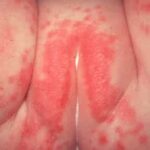Did you read the previous part about seborrheic dermatitis?
Avez-vous lu la partie précédente sur la dermatite séborrhéique?
When talking about fungal infections and babies, it’s usually a candida infection, a common yeast in humans.
Babies can have two types of infections, either acquired in utero, called congenital candidiasis, or after childbirth, called neonatal candidiasis.
Neonatal candidiasis commonly afflicts the mouth and diaper area. Oral afflictions, also known as thrush, are white patches that look like cottage cheese the baby’s mouth.
In the diaper area, large red patches that are bright red and flaky surrounded by small red pimples with whiteheads, called satellite lesions.
Explanations:
- A breastfed baby with a white tongue does not automatically have a fungal infection. The white patches associated with fungal infections are more intense and look like cottage cheese.
- A damp diaper with an alkaline pH promotes the development of a candida infection.
- This dampness is nourishing and perfect for the proliferation of the infection. This can be the mouth with leftover milk or a damp diaper.
Recommendations:
- Avoid dampness as much as possible by frequently changing diapers and drying the area each time.
- The first line of treatment for a candida skin infection is an over the counter antifungal cream (Monistat, Canesten, etc.) used twice a day for 7-10 day period.
- If the baby’s mouth is infected, you can use prescription Nystatin syrup. Talk to your doctor, pharmacist and nurse about this.

Photo source: web.pediatrics.wisc.edu
For more information, read When Fungal Infections Arrive!
Continue reading with diaper rash.
Source de la photo: web.pediatrics.wisc.edu
Pour plus d’information, consultez mon billet Quand les champignons arrivent.
On continue la lecture avec l’érythème fessier.


